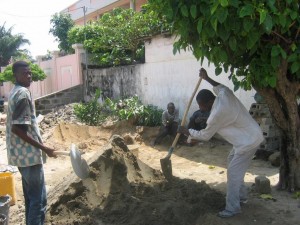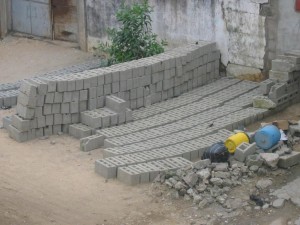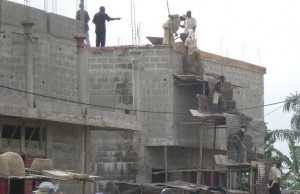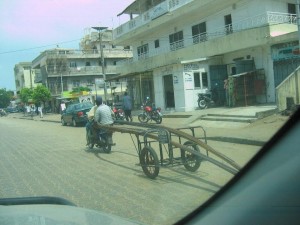In Africa it seems we just get past one crisis when another raises its head. This week it was the chapel. It started out with a demand from a judge that we pay the landlord a lot of money or he would lock up our building. In trying to dig to the bottom of the issue, it seems that the real estate people in Accra had been attempting to negotiate a new contract around the first of the year. When the negotiations didn’t go as planned they apparently just dropped the issue and the rent on the chapel had not been paid since last April. I guess you really couldn’t blame the landlord for being upset but it would have been helpful if he would have just let us know that the rent needed to be paid. Sometimes some people here act kind of like some Americans. It would also have been nice for the people in Accra, who seem to be quite proud of the fact that they are in charge of things, to either have taken care of their responsibility or at least to have notified us that they had failed, but that didn’t happen either. Hopefully after all the going back and forth the problem is now solved, but we don’t know for sure. Maybe we will have church tomorrow and maybe not.
On a brighter note, another temple trip was organized for this week, and we had 6 members go over to the temple for a couple of days. Even for the few branch members that have cars, getting in and driving to the temple is not an option. The process was quite interesting to us. We were asked to take them to the road to catch a taxi, so we were at the chapel at 8:00 on Thursday morning with the mission vehicle as agreed. Of the six going, one had decided to go earlier so we had 5 left. Only 2 were there when I arrived. Another showed up a little later and we began a search for the other two. We found them at the Relief Society President’s house finishing the preparations for food to take along. After a couple more trips here and there to pick up forgotten items, we finally got everyone on board and left them at the side of the road leaving town to catch a taxi. With all the suitcases, bags of food, etc. I thought this might be a problem, but after a few minutes negotiation with someone (I suppose a taxi broker) a couple of cars (taxis) stopped and the material was put into the trunks and everyone got in and away they went. I think there are a couple of reasons for this kind of arrangement. First, it is difficult and expensive to cross the borders (of which there are two between here and the temple in Accra) and becomes even more difficult and expensive if you have a car involved. Secondly, cars are very expensive and the people who have them just don’t use them on long distance runs. It is cheaper to get in with someone who does that for a living, ride to the border, cross on foot, and then catch another taxi to go to the next border. To our way of thinking it is strange, but it works in Africa. The group got back on Saturday night. I told them to give us a call when they got here and we would pick hem up and get them home. They did just after dark and were all thrilled with the experience. Paulette Hounkpatin, the mother of Elder Elvis who just left on his mission, was one who went for the first time and really enjoyed going. The temple is a very meaningful experience to these people who seems to have, in general, a little deeper spiritual roots than some other cultures. Another group is already planning to go in November so temple work is really starting to take hold in our little branch.
The Findlays left on Saturday to go back to Abidjan to continue with the measles campaign there and will be back here next Friday. I am really glad that we now have the extra bedroom ready for guests. They have spent all week making arrangements with the Ministry of Health for all of the advertising for the campaign. This includes big banners to be placed all over Benin, badges for the vaccinators to wear, flyers for local neighborhoods and TV and radio segments. This week Geoffroy, a local volunteer, will find the mothers and children to be in the TV advertisement. I helped him choose some from the branch today so that will be exciting to see some familiar faces on TV, that is if we had a TV. But we will get a DVD of the advertisement.
When we are involved in apartment, measles campaign preliminaries, etc., there are generally not very many opportunities for pictures to send home, so I have been saving a few ideas in my head for just such a week. We have mentioned before that there are many unfinished buildings in Benin as people only do the construction as long as they have the money. When their money is gone, they save until they can continue. We have seen buildings that look like they have been sitting for years. Soeur Julianne, in Calavie, is one such example. She has been living in a partial finished house for some time now and she was able to put in the electricity and water. When we went there on Thursday, it was exciting to have lights and her sewing machine plugged in. She even showed up with a serger (probably stored in the back room from when they previously lived in Cotonou). There was also a TV and refrigerator that were being used. Before her husband died, they were quite well off as he was a diplomat for the Benin government. After he died, she supported her family with her sewing. They had some land in Calavie that was protected for Julianne so she was able to partially build a house on it.
Now back to construction, which we find to be very interesting. Every building is made of cement but you do not see any cement trucks. All cement is mixed by hand on the street next to where the building site is.  Cement blocks are made by hand where the cement is mixed up and are left to dry before putting in place for the walls of the building. They have a metal mold, fill it up with cement, press it in tightly, remove the mold and let it dry.
Cement blocks are made by hand where the cement is mixed up and are left to dry before putting in place for the walls of the building. They have a metal mold, fill it up with cement, press it in tightly, remove the mold and let it dry.  You see rows of cement blocks all over the streets of Cotonou waiting to be used. It is relatively easy to lay the blocks on the ground level but is a little more difficult on the upper stories but is still done by hand. The first step is to pour cement for the next floor above the ground floor. They get hundreds of straight wooden poles to brace up the wood form for the floor, put in rebar for reinforcement and heist the cement up to that floor. The subsequent floors get a little more tricky as when each floor is poured and the walls put in place they must continue upward.
You see rows of cement blocks all over the streets of Cotonou waiting to be used. It is relatively easy to lay the blocks on the ground level but is a little more difficult on the upper stories but is still done by hand. The first step is to pour cement for the next floor above the ground floor. They get hundreds of straight wooden poles to brace up the wood form for the floor, put in rebar for reinforcement and heist the cement up to that floor. The subsequent floors get a little more tricky as when each floor is poured and the walls put in place they must continue upward.  This is done by shoveling a scoop of cement by hand up on each level of big stair-like forms until the scoop reaches the floor where it is needed. When blocks are needed on the upper floors they are heisted up from the bottom one at a time on a rope or from one level to the next like the cement. Outside walls, inside walls, kitchen cupboards, fences, you name it and it is made of cement.
This is done by shoveling a scoop of cement by hand up on each level of big stair-like forms until the scoop reaches the floor where it is needed. When blocks are needed on the upper floors they are heisted up from the bottom one at a time on a rope or from one level to the next like the cement. Outside walls, inside walls, kitchen cupboards, fences, you name it and it is made of cement.  Before painting, a light layer of cement is troweled over the blocks. I hope we never see an earthquake, but the floors never squeak.
Before painting, a light layer of cement is troweled over the blocks. I hope we never see an earthquake, but the floors never squeak.

We even have a Washington Huskies fan |